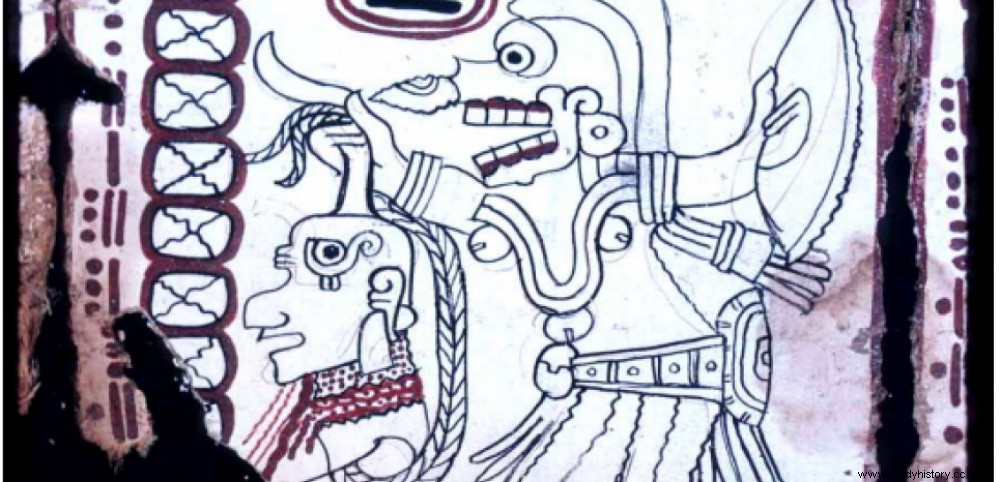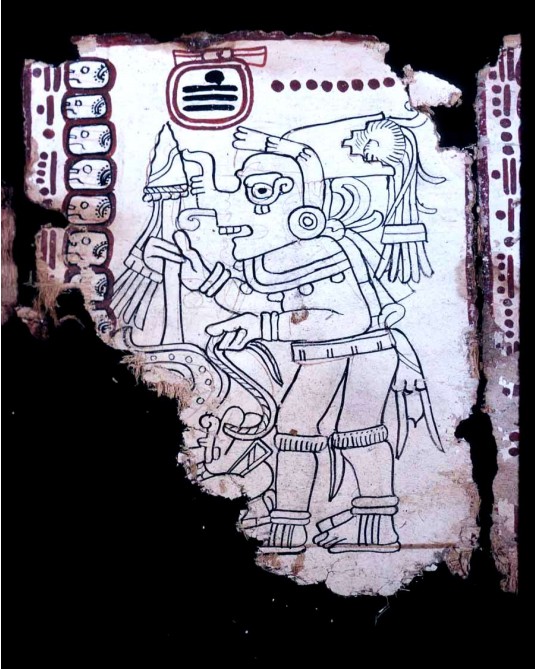 Knife in hand, a Mayan deity has just beheaded a shackled captive, whose blood spurts from the neck.
Knife in hand, a Mayan deity has just beheaded a shackled captive, whose blood spurts from the neck. AUTHENTICATION. Incredible turnaround. A famous Mayan codex, the Codex Grolier , presented as a fake for more than 40 years by some experts, has just been authenticated according to a study carried out by researchers from Brown University, in the state of Rhode Island (United States). Dated around 1230, it thus becomes at the same time... the oldest of the known manuscripts of America!
This "book" consists of 11 folded pages of amate paper (from Nahuatl amatl ), composed of vegetable fibers, out of the 20 that it was originally supposed to have. It had been discovered by looters in a cave in Chiapas (Mexico) in 1965, along with several objects including a mosaic mask and a sacrificial knife. This Mayan codex – whose name refers to the New York bibliophile club where it was presented in 1971 – had been sold to a Mexican collector named Josué Saenz. Painted black with just a few details colored with red hematite and "Mayan blue" (pigment), it was intended for tracking the movements of the planet Venus, the brightest celestial object in the sky after the sun and the sky. moon. The Maya indeed attached great importance to the movements of the planets in an attempt to anticipate the arrival of disastrous events (read box ). Each page of the codex was further decorated with the profile of an armed figure holding a kneeling captive bound at the end of a rope.
 Illustration of the Mayan god Kawil dressed as a Toltec warrior. Featuring a stepped nose ornament, it also wears quetzal bird feathers. A large part of the captive he holds has disappeared.
Illustration of the Mayan god Kawil dressed as a Toltec warrior. Featuring a stepped nose ornament, it also wears quetzal bird feathers. A large part of the captive he holds has disappeared.
© Michael Coe/Brown University
The incredible conditions of the discovery of this codex had led some experts to establish in the 1970s that it could have been made by forgers, suspicious cuts on some pages and the absence of certain themes common to Maya iconography leaving indeed think of a sham. An expertise against which had always risen the eminent American archaeologist Michael Coe, professor emeritus of Harvard University, as well as Stephen D. Houston, epigraphist of Brown University, convinced for their part of the authenticity of the document.
Researchers at Brown University have conducted new expertise, the results of which have been published on about fifty pages in the journal Maya Archeology . They detail their analyses, in particular those of the Mayan blue pigment whose composition was only discovered in 1980, which, according to them, excludes that it could have been known to forgers in the 1960s. Similarly, the new datings to carbon 14 attest to the antiquity of the document which would have been produced around 1230. Which would therefore make it the oldest "written" document in America, one of the very few that escaped the flames of the Spanish conquistadors in the XVI e century who considered them to be works of witchcraft. Only three other Maya codices have thus survived (their names coming from the places where they are preserved):that of Dresden (XIII e century), a treatise on divination and astronomy; that of Madrid (Tro-Cortesianus ) made between 1250 and 1450, also devoted to horoscopes and almanacs; like that of Paris (Codex Peresianus ). Fragments of other codices reduced to the state of heaps and found in Guatemala, Belize or Honduras are also preserved by scientists with the fragile hope that future techniques may one day allow access to the information they contain. .
The Groslier Codex will therefore perhaps leave the basements of the National Museum of Anthropology and History of Mexico, where it is currently stored among the questionable objects, to finally be exposed to the public.
The Maya and time
If Maya time is measured by a plurality of cycles (astronomical, ceremonial or dynastic), the correspondence between the cycles was of paramount importance for this pre-Columbian civilization. The Mayans feared above all the ruptures corresponding to the passage from one cycle to another, change being for them a source of danger. Convinced that the current world had been preceded by others and that each creation was followed by destruction, they sought to anticipate in order to maintain this cyclical order by relying on predictions. The Codex thus served to identify events and predict their recurrence. Thus, if a calamity had occurred in a certain period, another catastrophe was to be expected at the end of the same cycle. Knowing the past let them imagine mastering the future. The Mayan interest in the stars therefore had an astrological and not an astronomical purpose.
